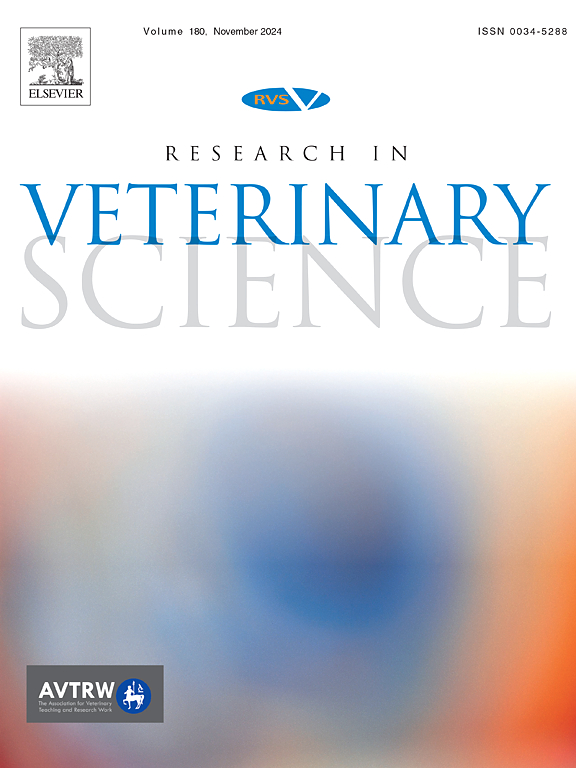1951 - 2024年lagomorpha球虫病全球流行情况:系统回顾和荟萃分析。
IF 2.2
3区 农林科学
Q1 VETERINARY SCIENCES
引用次数: 0
摘要
通过对1951年至2024年间发表的149项研究的荟萃分析,调查了狐猴球虫感染的全球流行情况及其潜在危险因素。其中艾虫科、肉囊虫科和隐孢子虫科的总流行率分别为66.0%、8.0%和6.1%。家兔和野兔的隐孢子虫科感染率最高,分别为63.1%和71.8%,鼠兔的隐孢子虫科感染率最高,为17.1%。南半球隐孢子虫科的流行率最高(11.4%)。非洲区艾扁虫科(73.3%)和肉囊虫科(14.6%)感染率最高,东地中海区隐孢子虫科(13.6%)感染率最高。雏兔艾虫科患病率最高(67.4%),成年兔肉囊虫科患病率最高(17.1%),隐孢子虫科患病率最高(13.1%)。随着时间的推移,集约化养殖lagomorphi的球虫感染率呈轻微上升趋势,接近具有统计学意义(R2 = 7.88%,系数= 0.019,P = 0.127)。这表明目前的集约化养殖方法可能正在失去控制球虫感染的有效性,这是令人担忧的。在狐形目艾美球虫科中,coquelin艾美球虫的感染率最高(68.4%),而magna艾美球虫的感染率最高。在肉囊虫科中,以贝氏虫最高(31.3%),以刚地弓形虫最常见。隐孢子虫是隐孢子虫科最常见和最常报道的一种(6.9%),提示其可能是狐形目隐孢子虫科的主要病原体。这些发现突出了艾美拉属中不同种类艾美拉属的流行率差异。这种多样性强调了特定寄生虫与其宿主物种之间的复杂关系,有助于更细致地了解世界范围内lagomorphi的球虫病流行病学。本文章由计算机程序翻译,如有差异,请以英文原文为准。

Global prevalence of lagomorpha coccidiosis from 1951 to 2024: A systematic review and meta-analysis
The global prevalence of coccidia infection in lagomorphs and potential risk factors were investigated through a meta-analysis of 149 studies published between 1951 and 2024. The pooled prevalence of Eimeriidae, Sarcocystidae and Cryptosporidiidae was found to be 66.0 %, 8.0 % and 6.1 %, respectively. Rabbits and hares exhibited the highest prevalence of Eimeriidae at 63.1 % and 71.8 %, while pikas had the highest prevalence of Cryptosporidiidae at 17.1 %. Countries located in the southern hemisphere exhibited the highest prevalence of Cryptosporidiidae (11.4 %). The African Region had the highest prevalence of Eimeriidae (73.3 %) and Sarcocystidae(14.6 %), while the Eastern Mediterranean Region had the highest prevalence of Cryptosporidiidae(13.6 %). Juvenile rabbits exhibited the highest prevalence of Eimeriidae (67.4 %), while senior Rabbit exhibited the highest prevalence of Sarcocystidae(17.1 %) and Cryptosporidiidae(13.1 %). The prevalence of coccidia in intensively farmed lagomorphs showed a slight upward trend over time, nearly reaching statistical significance (R2 = 7.88 %, coefficient = 0.019, P = 0.127). This suggests that the current intensive farming practices may be losing effectiveness in controlling coccidia infections, which is concerning. Among Eimeriidae in lagomorphs, Eimeria coquelinae showed the highest prevalence (68.4 %), while E. magna was most frequently reported. For Sarcocystidae, Besnoitia spp. had the highest prevalence (31.3 %), with Toxoplasma gondii being most frequently reported. Cryptosporidium cuniculus was both the most prevalent and frequently reported Cryptosporidiidae species (6.9 %), suggesting it may be a major Cryptosporidiidae pathogen in lagomorphs. These findings highlight the differences in prevalence of various Eimeriida species among different lagomorpha genera. This diversity underscores the complex relationships between specific parasites and their host species, contributing to a more nuanced understanding of coccidiosis epidemiology in lagomorphs worldwide.
求助全文
通过发布文献求助,成功后即可免费获取论文全文。
去求助
来源期刊

Research in veterinary science
农林科学-兽医学
CiteScore
4.40
自引率
4.20%
发文量
312
审稿时长
75 days
期刊介绍:
Research in Veterinary Science is an International multi-disciplinary journal publishing original articles, reviews and short communications of a high scientific and ethical standard in all aspects of veterinary and biomedical research.
The primary aim of the journal is to inform veterinary and biomedical scientists of significant advances in veterinary and related research through prompt publication and dissemination. Secondly, the journal aims to provide a general multi-disciplinary forum for discussion and debate of news and issues concerning veterinary science. Thirdly, to promote the dissemination of knowledge to a broader range of professions, globally.
High quality papers on all species of animals are considered, particularly those considered to be of high scientific importance and originality, and with interdisciplinary interest. The journal encourages papers providing results that have clear implications for understanding disease pathogenesis and for the development of control measures or treatments, as well as those dealing with a comparative biomedical approach, which represents a substantial improvement to animal and human health.
Studies without a robust scientific hypothesis or that are preliminary, or of weak originality, as well as negative results, are not appropriate for the journal. Furthermore, observational approaches, case studies or field reports lacking an advancement in general knowledge do not fall within the scope of the journal.
 求助内容:
求助内容: 应助结果提醒方式:
应助结果提醒方式:


